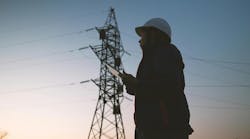For more than two weeks last September, 1,350 men and women came together to battle the flames that burned more than 34,000 acres of Bastrop County in Texas. Racing alongside, working tirelessly were about 80 Bluebonnet Electric Cooperative workers and 450 hired contractors; the co-op's other 208 employees helped members throughout the emergency efforts.
Asplundh and McCoy Tree Surgery crews, led by Bluebonnet workers, cleared trees endangering power lines, chipped trees and hauled away debris. Area construction crews from Line Tech, Richardson and T&D were hard at work, also. The Bluebonnet crews cut off power in advance of the firefighters to keep them, emergency workers and residents safe. They opened fuses and breakers on power poles and remotely cut power at substations from the control center.
Within a few hours of the fires starting, the company evacuated its headquarters and brought its alternate control room on-line. Almost immediately after the fires started, Bluebonnet began implementing its power-restoration plan. Its focus was on making the area safe and restoring power as quickly as possible. Because of this, the utility was able to completely restore power to all areas affected by the fires within three weeks, nearly two weeks earlier than originally estimated.
Coordinating Crews
The utility devoted countless hours to training and preparing its responding agencies to follow the National Incident Management System. This system is a model for managing a massive disaster, one that requires help from multiple agencies and jurisdictions.
The fact that all partners in the firefighting effort worked within that system was key to the organized, coordinated response to the fire, said Mike Fisher, the coordinator of the Bastrop Office of Emergency Management. At the peak of activities, more than 1,200 responders and electric workers were coordinated safely and effectively by its local, regional, state and federal partners.
As quickly as flames were extinguished, Bluebonnet's crews and contractors began the difficult work of restoring power. They removed downed lines and burned transformers, and replaced poles. Crews removed burned trees and debris. Bluebonnet deployed 120 right-of-way/debris removal crews, 70 crews to chip and haul away burned trees for recycling, and another 23 crews to restore power.
In his opinion, Fisher added, that cooperation was “a wonderful and historic moment for all that participated in what may be the most severe and tragic wildfire event in central Texas history.” Bluebonnet had 4,338 meters along more than 200 miles of power lines in the burned area.
Restoring Power
The co-op began getting requests from members to reconnect power almost immediately, even if only to power a motor home parked next to a destroyed home. The power was back on to everyone three weeks after the blaze began.
On Day 1, at the same time Bluebonnet Electric Cooperative's headquarters in Bastrop was being evacuated and an alternate control room was being set up in another location, crews were in the field, cutting off power to keep first responders safe.
The field crews de-energized locally and remotely, said Eric Kocian, the manager of electric operations and engineering, who has been at Bluebonnet for more than eight years.
At the backup site, planning began. General Manager Mark Rose and COO Matt Bentke took the lead in keeping members and the media informed, working with emergency officials and organizing upcoming field operations.
The wait to be allowed into the burn zone, which eventually totaled more than 34,000 acres, gave Bluebonnet's teams time to plan how to best tackle the massive effort of removing potential dangers and safely restoring power. Thanks to the co-op's rigorous emergency-management plan and disaster training, decisions were made swiftly. Calls went out to right-of-way and construction contractors from across the region and state.
Executing the Plan
On Day 4, Bluebonnet crews were given access to enter part of the burn zone, and they quickly realized more help was needed. Eventually, more than 450 contractors worked alongside 80 Bluebonnet employees in the field. The next day, the entire burn zone was opened up to the field workforce. At that point, it became more clear as to who was doing what, and as a result, everyone got better organized. They followed the Southern Incident Command Team's lead, dividing the burn zone into three areas. They also streamlined the chain of command so that three superintendents, one for each area, were reporting to a single superintendent, who reported directly to the COO.
It was, of course, not business as usual. Normally an engineering employee in the co-op's line-design group maps out where and how poles, lines and other equipment are placed, then construction crews head out to follow their plans.
To be more effective and efficient, line-design group members were teamed with construction workers. The pairing allowed form and function to merge quickly.
Throughout the process, advanced technology played a crucial role. It allowed the co-op to quickly establish a technologically strong alternate control center. Advanced mapping systems guided crews into burn zones. GPS technology in the trucks made the crews' locations available at all times. Mobile data software allowed line-design workers in the field to electronically communicate what materials would be needed the next day.
Communicating with the Community
On Day 5, Bluebonnet technicians placed a map of the burn zone on the co-op's website and overlaid it with a color-coded map estimating when power would be restored to different areas. The map, available to members and the public, was updated daily for the next 18 days, through Sept. 26. It gave members specific information at a time when specifics were often in short supply.
The map was posted at every news conference and at evacuation shelters, and picked up by the media on a daily basis, Rose said. It also served as a valuable resource to emergency-management officials when they were deciding which areas were safe for residents to re-enter and when.
Detailed information and hundreds of updates were posted on Bluebonnet's Facebook and Twitter pages. Member service centers extended their hours, and representatives worked with members without power and, in many cases, without homes. The company's other employees stepped in to maintain operations for the roughly 90% of Bluebonnet members who were not directly impacted by the fire.
With every passing day, crews made increasingly accurate estimates of time for repairs and cleanup. Daily huddles, nightly conference calls, and regular discussions with emergency-response experts and community representatives kept everyone informed and coordinated.
“I think the main thing was that our guys wanted to restore power as safely and quickly as they could. That's their job, day in and day out. It was a big and tragic event, but their focus was the same,” Kocian said. “They were working 16-hour days, but safety protocols kept them to strict deadlines for when it was time to stop and rest.”
Bluebonnet's emergency-response plan is a living document, and every day the technicians are at some level of their emergency-response plan. On a normal day, they are at level one, but having that plan in place helps the entire organization know what to do in case of an emergency.
Reconnecting Meters
Two weeks after the fire, work began to shift to reconstructing or providing new service for members who had lost homes. The crews had been restoring power and clearing right-of-way. Then dozens of work orders came in from members requesting technicians to reconnect their meters, creating a second wave of activity. As such, Bluebonnet set a goal of getting the jobs built in three days after the member requested it.
“One of the things that helped more than any was the field crews seeing there was a light at the end of the tunnel,” Kocian said. “Once you start getting power back on and you can see the finish line, motivation grows stronger.”
As the days passed, work became increasingly efficient and power was restored ahead of schedule. Crews worked 252 miles of line in the burn zone. The last power outage was restored 19 days after crews began working in the burn zone, two weeks earlier than estimated.
Hundreds of members who lost their homes have asked for power to be restored. An estimated 1.5 million trees died or are expected to die. By the end of October, more than 42,000 cubic yards of debris had been removed for recycling. More than 1,000 poles have been replaced.
Throughout the restoration effort, the linemen had a hero mentality when it came to restoring power, Kocian said. The field crews received a lot of compliments from the members, and those kind words made all the hard work worthwhile, Kocian said.
Melissa Segrest ([email protected]) is a contributing writer for Bluebonnet Electric Cooperative.
Bluebonnet Lineman Gets Married During Fire Restoration
A wildfire that raged through Bastrop County, Texas, didn't put a stop to apprentice lineman Jeffrey Bolding's plans to marry his girlfriend, Brittany. On his wedding day, he was helping his crew to restore power.
The couple first postponed their wedding because they wanted the focus to be on helping the town of Bastrop. Several of their family members were in town as fire-recovery volunteers, however, so the couple decided 24 hours before the original date to get married on Sept. 10, 2011. Clad in jeans, a work shirt and dirty boots, Jeffrey took his 30-minute lunch break to wed Brittany in front of 50 friends and family members before returning back to work in his crew truck.
The Bastrop County Complex fire was one of the most destructive wildfires in Texas history, destroying thousands of homes, killing two people and inflicting about $325 million of insured property damage. Fire officials reported that high winds toppled trees, which fell on to power lines at two locations. As a result, the lines created sparks, which ignited the dry grass, according to newspaper reports.
Companies mentioned:
Asplundh Tree Expert Co. | www.asplundh.com
Bluebonnet Electric Cooperative www.bluebonnetelectric.coop
Line-Tec Inc. | www.linetec.com
McCoy Tree Surgery | www.mccoytree.com
T&D Solutions | www.tdsolutions.com

